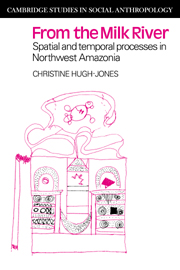Book contents
- Frontmatter
- Contents
- List of figures, tables and maps
- List of myths
- Preface
- Acknowledgements
- Orthography
- 1 Introduction
- 2 Social structure
- 3 The set of specialist roles
- 4 Kinship and marriage
- 5 The life-cycle
- 6 Production and consumption
- 7 Concepts of space–time
- 8 Conclusion
- Appendix 1 Named groups
- Appendix 2 Kinship terminology
- Works cited
- Index
- CAMBRIDGE STUDIES IN SOCIAL ANTHROPOLOGY
1 - Introduction
Published online by Cambridge University Press: 07 October 2009
- Frontmatter
- Contents
- List of figures, tables and maps
- List of myths
- Preface
- Acknowledgements
- Orthography
- 1 Introduction
- 2 Social structure
- 3 The set of specialist roles
- 4 Kinship and marriage
- 5 The life-cycle
- 6 Production and consumption
- 7 Concepts of space–time
- 8 Conclusion
- Appendix 1 Named groups
- Appendix 2 Kinship terminology
- Works cited
- Index
- CAMBRIDGE STUDIES IN SOCIAL ANTHROPOLOGY
Summary
Focus of the study
Pirá-paraná Indians see themselves as existing within an ordered cosmos created in the ancestral past. The world of their present-day experience is a residue or product of the ancestral doings related in myth, ritual chants and shamanic spells. From their own point of view, this cosmos and the mythical deeds associated with it control their contemporary social life and provide a moral framework for present-day action. Here, I work the other way round – from the inside out.
Instead of starting with the cosmology, I start with the building of basic units of social structure, families and patrilineal groups, through marriage and procreation. I begin by showing how different phases of that temporal processes are associated with different spaces within and around the longhouse and end by showing that the very same ‘space–time’ principles underlie the structure of the cosmos. I argue as if the basic principles of social structure were primary and the cosmos was a reflection of these but I do not mean to imply that there is a simple relation of cause and effect between the two or that they should be seen as ‘infrastructure’ and ‘superstructure’.
The anthropologist must regard the ancestral cosmos as an imaginary projection of present experience, but at the same time it is a projection which both controls present experience and forms an integral part of it.
- Type
- Chapter
- Information
- Publisher: Cambridge University PressPrint publication year: 1980

